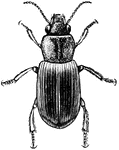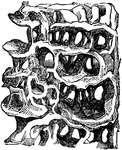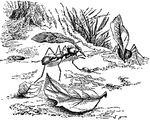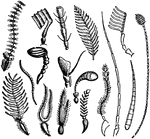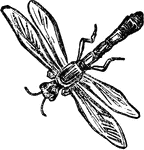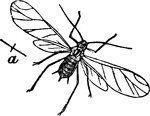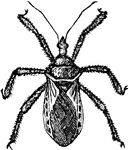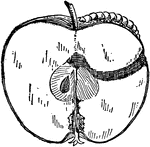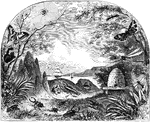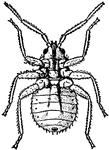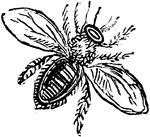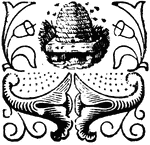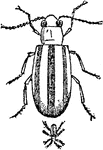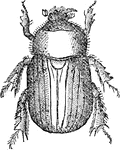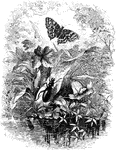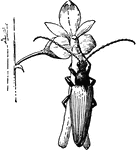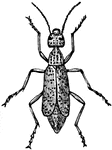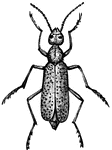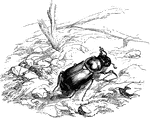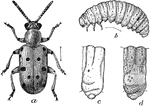
Crioceris 12-Punctata
"The mature beetle in life rivals asparagi in beauty, but may be distinguished by its much broader elytra…

Siro Americanus
"The typical genus of Sironidae. Two species inhabit Europe, one the Philippines, and another (undescribed)…
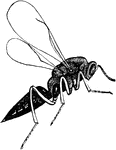
Abdomen
"The belly; that part of the body of a mammal which lies between the thorax and the pelvis; In entomology,…
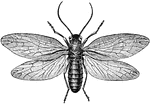
Alderfly
The Alderfly (Sialis infumata) is an insect in the Megaloptera order of alderflies, dobsonflies, and…
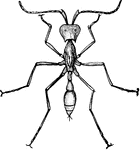
Army Ant
The soldier of Eciton drepanophorum, a species of army ant in the Formicidae family of ants.

White Ants
"These animals, often called White Ants, live in vast communities, principally in the hotter…
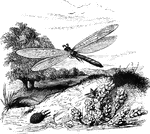
Antlion and Larva
"In some species the larvae, which are small, sluggish, oval-shaped creatures, and furnished with a…
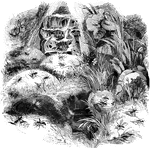
Ants and Their Structures
"This tribe, which includes the various kinds of Ants, is composed entirely of insects which live in…
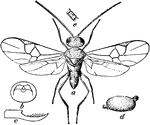
Apanteles aletiæ
"Apanteles aletiæ, much enlarged. ITs species infest various lepidpterous larvæ, and form…

Woolly Aphid Larva
The female woolly aphid larva (Schizoneura lanigera), a species of plant lice of the Eriostoma family.

Assassin Bug
Ectrichodia cruciata is a species of assassin bugs in the Hemiptera order of true bugs.
Bean Aphis
Bean aphis have membranous and naked wings with few supporting nervures. Some species are wingless.
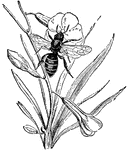
Bee Pollinating a Flower
"Bee, the common name given to a large family of hymenopterous or membranous-winged insects, of which…
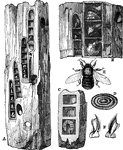
Carpenter Bee
"A, B, C, tunnelings of the carpenter bee; E, the carpenter bee; D, a partition; F, teeth, magnified"…
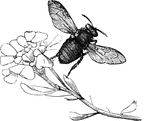
Drone Bee
"The working bee, for collecting wax, enters a flower, the stamens of which are loaded with pollen.…
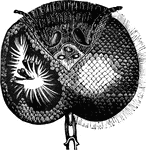
Eyes of a Bee
"The eyes, which are among the most wonderful objects in nature, are almost always of the kind called…
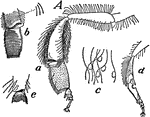
Legs of the Hive Bee
Honey bees (or honeybees) are a subset of bees, primarily distinguished by the production and storage…
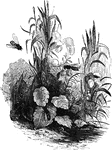
Honey Bee
"They are said to have originated in Greece, but have since spread all over the world; they live in…

Honey Bee (Male)
Honey bees (or honeybees) are a subset of bees, primarily distinguished by the production and storage…
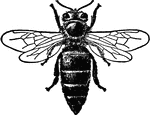
Honey Bee (Queen)
Honey bees (or honeybees) are a subset of bees, primarily distinguished by the production and storage…

Honey Bee (Worker)
Honey bees (or honeybees) are a subset of bees, primarily distinguished by the production and storage…
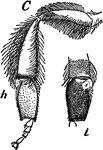
Legs of the Humble Bee
A bumblebee (or bumble bee) is any member of the bee genus Bombus, in the family Apidae. Pictured here…

Mason Bee
"The Mason Bee, Osmia, of which there are many kinds, makes its cells in spaces from which…

Mouth and Tongue of a Bee
"The structure of the mouth in insects exhibits very remarkable modifications, and these are of the…
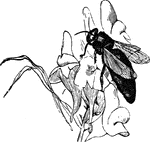
Queen Bee
"The queen bee is larger and longer than the other bees; she moves in a slow and majestic manner, and…

Legs of the Stingless Bee
Stingless bees, or simply meliponines, are a large group of bees, comprising the tribe Meliponini in…

Working Bees
""The working bee, for collecting wax, enters a flower, the stamens of which are loaded with pollen.…

Bees Secreting Wax
"The secretion of wax, it would appear, goes on best when the bees are in a state of repose, and the…
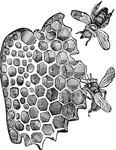
Cells of Honey Bees
"The hexagonal cells for the honey are build upon precisely that mathematical angle which affords the…
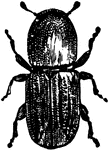
Bark Beetle
A bark beetle is one of approximately 220 genera with 6,000 species of beetles in the subfamily Scolytinae.…

Blackspotted Pliers Support Beetle
"The Leptura Mordax, or Rhagium Mordax of Europe, three-fourths of an inch long,…

Blister Beetle
Beetles (Coleoptera) in the family Meloidae are commonly known as blister beetles, after their defensive…
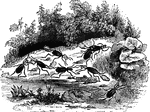
Bombadier Beetle
"The bombadier beetle has a large oval abdomen, which secretes a caustic fluid. They live in societies,…
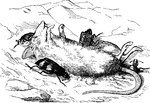
Burying Beetles
"The Burying Beetles are prompted by their insect to bury any small animals or pieces of carrion as…
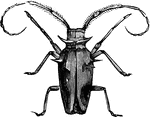
Capricorn Beetle
"The insects of this tribe, called Capricorn Beetles and distributed throughout most parts…
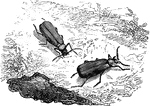
Cardinal Beetle
"One of the most beautiful of the European species of trachelia is the Pyrochroa rubens, which…
